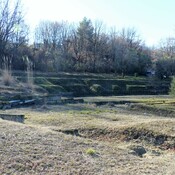Il n'y a pas une annotation en français. Présenté est une annotation en Anglais.
Aegae: ancient capital of Macedonia, site of the royal cemetery. See http://www.livius.org/ad-af/aegae/aegae.htm
Macedonian Royal Tombs at Aigai - Vergina is a huge mound under which,as many schlars believ the King Philip II (369-336 BC), father of Alexander the Great, and other members of the royal family of the Macedons were burried. The tumulus is 13m high and roughly 100m in diameter.
Tomb I.
Measures: 3.50 x 2.09 m and 3 m high. Known as the Tomb of Persephone - contains a fresco of the abduction of Persephone by Hades on one wall and the mourning Demeter, Persephone’s mother. In there were burried the bones of a mature male, a young female, and an infant It is most likely the tomb of Philip Ii and his young wife Cleopatra, and their infant child1.
Tomb II.
Manolis Andronicos2 claimed that Tomb II belonged to Philip II and one of his young wives -Cleopatra or Meda killed after the death of Philip II in 336 BC3.. The grave contains the remains of a male and a young female. According to P. W. Lehmann it is a burial of Philip Arrhidaeus (c .356-317) , brother of Alaxander the Great and his wife Eurydice, who both died in 317 BC45. The remains of the pottery suggest the period after the death of Philip II6.
Tomb III.
Untouched by robbers. Alexander IV, the son of Alexander the Great?
Heroon
See:
- The Royal Tombs at Vergina: A Brief Account of the Excavations." In The Search for Alexander: An Exhibition, by Greek Ministry of Culture and Sciences, pp. 26-38. The Greek Ministry of Culture and Sciences,1980
- Ernst Badian: The death of Philip II, in: Phoenix 17/ 4 , 1963, pp.244-250.
- Phyllis Williams Lehmann: The So-Called Tomb of Philip II: An Addendum in: American Journal of Archaeology 86, 3 (Jul. 1982): pp. 437-442
- David Gill, Tomb II at Vergina: making sense of the weight inscriptions, Cardiff University-https://www.academia.edu/9429301
- idem: Inscribed silver plate from Tomb II at Vergina, in: Hesperia 77, 2008, pp. 335–358
- Cindy G Levesque, The Royal Tombs at Vergina, Classics 5013 – Honours Thesis, University of New Brunswick 2012, re-edited for upload on Academia in April 2017
- Evan Pitt, The Consequences of a Burial at Vergina, Conference paper presented at the AMPHORAE 7 Conference, hosted by the University of Sydney in 2013 - https://www.academia.edu/2008928
- Despina Ignatiadou: Royal identities and hidden symbolism in the Vergina lion-hunt painting, Archaiologikon Deltion 57, 2002, A, pp. 119 -154
- Antonis Bartsiokas et all: The lameness of King Philip II and Royal Tomb I at Vergina, Macedonia, PNAS - http://www.pnas.org/content/112/32/9844.full
Références
- ↑C. G. Levesque, 2012, p. 17
- ↑M. Andronicos, 1980, p 26ff
- ↑E. Badian 1963, pp. 246-247
- ↑ P.W. Lehmann 1980, p. 529-530
- ↑E. Pitt. 2013
- ↑C. G. Levesque, 2012, p. 17
Aegae: ancient capital of Macedonia, site of the royal cemetery. See http://www.livius.org/ad-af/aegae/aegae.htm
Macedonian Royal Tombs at Aigai - Vergina is a huge mound under which,as many schlars believ the King Philip II (369-336 BC), father of Alexander the Great, and other members of the royal family of the Macedons were burried. The tumulus is 13m high and roughly 100m in diameter.
Tomb I.
Measures: 3.50 x 2.09 m and 3 m high. Known as the Tomb of Persephone - contains a fresco of the abduction of Persephone by Hades on one wall and the mourning Demeter, Persephone’s mother. In there were burried the bones of a mature male, a young female, and an infant It is most likely the tomb of Philip Ii and his young wife Cleopatra, and their infant child1.
Tomb II.
Manolis Andronicos2 claimed that Tomb II belonged to Philip II and one of his young wives -Cleopatra or Meda killed after the death of Philip II in 336 BC3.. The grave contains the remains of a male and a young female. According to P. W. Lehmann it is a burial of Philip Arrhidaeus (c .356-317) , brother of Alaxander the Great and his wife Eurydice, who both died in 317 BC45. The remains of the pottery suggest the period after the death of Philip II6.
Tomb III.
Untouched by robbers. Alexander IV, the son of Alexander the Great?
Heroon
See:
- The Royal Tombs at Vergina: A Brief Account of the Excavations." In The Search for Alexander: An Exhibition, by Greek Ministry of Culture and Sciences, pp. 26-38. The Greek Ministry of Culture and Sciences,1980
- Ernst Badian: The death of Philip II, in: Phoenix 17/ 4 , 1963, pp.244-250.
- Phyllis Williams Lehmann: The So-Called Tomb of Philip II: An Addendum in: American Journal of Archaeology 86, 3 (Jul. 1982): pp. 437-442
- David Gill, Tomb II at Vergina: making sense of the weight inscriptions, Cardiff University-https://www.academia.edu/9429301
- idem: Inscribed silver plate from Tomb II at Vergina, in: Hesperia 77, 2008, pp. 335–358
- Cindy G Levesque, The Royal Tombs at Vergina, Classics 5013 – Honours Thesis, University of New Brunswick 2012, re-edited for upload on Academia in April 2017
- Evan Pitt, The Consequences of a Burial at Vergina, Conference paper presented at the AMPHORAE 7 Conference, hosted by the University of Sydney in 2013 - https://www.academia.edu/2008928
- Despina Ignatiadou: Royal identities and hidden symbolism in the Vergina lion-hunt painting, Archaiologikon Deltion 57, 2002, A, pp. 119 -154
- Antonis Bartsiokas et all: The lameness of King Philip II and Royal Tomb I at Vergina, Macedonia, PNAS - http://www.pnas.org/content/112/32/9844.full
Références
- ↑C. G. Levesque, 2012, p. 17
- ↑M. Andronicos, 1980, p 26ff
- ↑E. Badian 1963, pp. 246-247
- ↑ P.W. Lehmann 1980, p. 529-530
- ↑E. Pitt. 2013
- ↑C. G. Levesque, 2012, p. 17
Presumed tomb of Philip II or III of Macedon
Literature
-
Olga Palagia, "Hephaestion's Pyre and the Royal Hunt of Alexander" in: Bosworth/Baynham, Alexander the Great in Fact and Fiction (1999)



